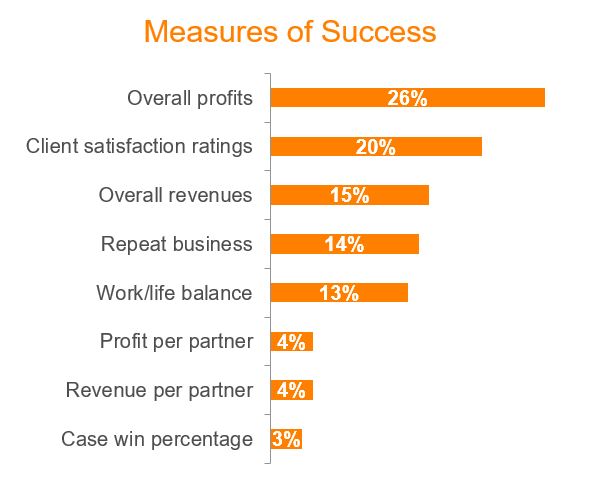 How much revenue do solo and small-firm lawyers bring in? How do they define success? How well are they doing at achieving it? What do they consider their greatest challenges? What are they doing to address them? How do they allot their time in a day?
How much revenue do solo and small-firm lawyers bring in? How do they define success? How well are they doing at achieving it? What do they consider their greatest challenges? What are they doing to address them? How do they allot their time in a day?
These questions and others are answered in a new survey of small-solo law firm management conducted by the Thomson Reuters Solo and Small Law Firm group. I’ve been given exclusive access to the survey results and today I’ll sum up key findings. I’ll dig deeper into the data in subsequent posts at my LawSites blog, so watch for them there.
Overall, the survey paints a picture of a segment of the legal profession that faces substantial challenges in balancing the demands of law practice against those of managing their firms. They face competition on multiple fronts and increasing demands from clients to do more for less. Management tasks take up some 40 percent of their time. Yet, even in the face of all this, the vast majority consider their firms to be successful.

Why Your Practice Is Burning Money And How You Can Do Better
Our expert panel explores common sources of profit leakage along with practical steps for improvement.

One of the most striking findings of the survey – which covered firms of fewer than 30 attorneys – is how lawyers spend their days. Overall, small-firm attorneys spend just 61 percent of their time practicing law. Solos spend barely more than half their time, 55 percent, practicing law. The larger the firm, the more time devoted to practicing law. Lawyers at firms of 11-29 attorneys spend 69 percent of their time practicing law.
For the lawyers surveyed, the rest of their time is taken up by meeting or speaking with clients (12 percent of their time overall), managing the firm (11 percent), administrative tasks (10 percent), and growing the firm and marketing activities (6 percent). There is a reverse correlation between firm size and time spent with clients: the smaller the firm, the more time a lawyer spends with clients. Solos spend 16 percent of their time with clients, while those in 11-29 lawyer firms spend 8 percent.
How does that allotment of time translate to revenue? The survey did not ask about net earnings but it did ask about revenue. Among solos, roughly two-thirds have annual revenues under $200,000, with 28 percent under $100,000. Three percent of solos have revenues of $600,000 to $1 million, and none bring in more than that.

Introducing LexisNexis Protégé™ in Lex Machina®
Lex Machina harnesses generative AI capabilities to revolutionize the way legal professionals interact with data to improve bottom line for their business.
At the other end of the small-firm spectrum, no firm in the 11-29 lawyer range has less than $1 million in revenue. A third have revenue of $1 million to $5 million, a third have revenue over $5 million, and a third do not say.
When the survey asked lawyers to identify the most significant challenge their firms face, the top three results would surprise no one who has worked in a small firm:
- Acquiring new client business (27 percent).
- Clients demanding more for less or rate pressure from clients (21 percent).
- Spending too much time on administrative tasks (15 percent).
I was surprised, however, to see that lawyers rank as their fifth greatest challenge the increasing complexity of technology (12 percent). This is particularly true among firms of 7-10 lawyers, where 20 percent rank it as their greatest challenge, and among solos, where 16 percent do.
Even more surprising is how firms are responding to these challenges – or, I should say, not responding. Of the top three significant challenges listed above, only a minority of firms are taking action to address them. With regard to acquiring new business, 37 percent of firms say they have taken steps to address this challenge; with regard to pressure from clients, 28 percent say they have taken action; and with regard to administrative tasks, 19 percent say they have taken action.
What are small firms’ greatest sources of competition? According to the survey, 67 percent of lawyers say it is other law firms of similar size to theirs, and 49 percent say it is significantly larger law firms that compete for the same clients.
However, in a clear sign of the times, the next two highest-ranked sources of competition are consumers who represent themselves pro se (13 percent) and do-it-yourself legal websites or services (11 percent).
Among other findings of the survey, which covered 301 firms, two-fifths of which were solos:
- Fifty-two percent of small firms have adopted new technology within the last two years.
- Thirty-six percent have changed their marketing strategy within the last two years.
- Fourteen percent have changed their billing practices within the last two years.
- Sixty-two percent of firms have no succession plan in place. More surprisingly, 83 percent of solos have no succession plan.
Particularly interesting is what the survey reveals about how lawyers evaluate their own success. The survey asked two questions: Which of a list of factors are relevant to defining success, and which of those factors is the primary measure of success?

The top four factors by which lawyers measure success overall are client satisfaction ratings (88 percent), repeat business (87 percent), overall profits (82 percent) and work/life balance (81 percent). But when asked to identify the one factor that is the primary measure of success, the most highly rated is overall profits (26 percent), followed by client satisfaction ratings (20 percent) and overall revenues (15 percent).
Here again, the measures of success varied by firm size. For solos, the greatest indicator of success is client satisfaction rankings. In every other sized firm, lawyers say overall profits is the greatest indicator of success.
Having asked how lawyers measure success, the survey then asked them to characterize their own firm’s success. Overall, 36 percent say their firms are very successful and 49 percent say they are successful. Only 4 percent say they are not successful and 11 percent say they are neither successful nor unsuccessful. More solos describe themselves as unsuccessful (8 percent), while more lawyers in firms of 11-29 describe themselves as very successful (44 percent).
Think about those numbers for a second. Eighty-five percent of small-firm lawyers consider themselves successful or very successful. That seems to fly in the face of conventional wisdom, which holds that many lawyers are struggling and miserable, particularly in smaller firms. Based on this survey, at least, small-firm lawyers may have obstacles to overcome, but overall they are doing just fine, thank you.
More details to come at my LawSites blog, as I drill down into the results over the next couple of weeks.
Robert Ambrogi is a Massachusetts lawyer and journalist who has been covering legal technology and the web for more than 20 years, primarily through his blog LawSites.com. Former editor-in-chief of several legal newspapers, he is a fellow of the College of Law Practice Management and an inaugural Fastcase 50 honoree. He can be reached by email at [email protected], and you can follow him on Twitter (@BobAmbrogi).